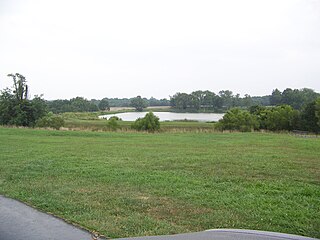
Clark County is a county located in the U.S. state of Kentucky. As of the 2010 census, the population was 35,613. Its county seat is Winchester. The county was created in 1792 from Bourbon and Fayette counties and is named for Revolutionary War hero George Rogers Clark.

The Transylvania Colony, also referred to as the Transylvania Purchase, was a short-lived, extra-legal colony founded during 1775 by land speculator Richard Henderson, who controlled the North Carolina-based Transylvania Company. Henderson and his investors had reached an agreement to purchase a vast tract of Cherokee lands west of the southern and central Appalachian Mountains through the acceptance of Treaty of Sycamore Shoals with most leading Cherokee chieftains then controlling these lands. To further complicate matters, this early American frontier land was also claimed at the same time by both the Province of Virginia and the North Carolina colony.

Kentucky County was formed by the Commonwealth of Virginia from the western portion of Fincastle County effective December 31, 1776. During the three and one-half years of Kentucky County's existence, its seat of government was Harrodstown.

Boone Station State Historic Site was a 46-acre (190,000 m2) Kentucky State Historic Site on Boone's Creek near Athens in Fayette County, Kentucky, USA.

The Siege of Boonesborough took place in September 1778 during the American Revolutionary War. The attack on the Kentucky settlement of Boonesborough was led by Chief Blackfish, a Shawnee leader allied to the British. Months before the battle, Blackfish had captured and adopted Daniel Boone, the founder of Boonesborough. Boone escaped the Shawnees in time to lead the defense of the settlement. Blackfish's siege was unsuccessful and was lifted after ten days. Boone was then court-martialed by fellow officers who suspected him of having British sympathies. Boone was acquitted, but he soon moved away from Boonesborough.
Richard Callaway or Richard Calloway was a longhunter and early settler of Kentucky. Born in Caroline County, Virginia, Callaway joined Daniel Boone in 1775 in marking the Wilderness Road into central Kentucky, becoming one of the founders of Boonesborough, Kentucky. He took part in organizing the short-lived colony of Transylvania.

Squire Maugridge Boone Jr., Squire Boone Jr., or Squire Boone was an American frontiersman, longhunter, soldier, city planner, politician, land locator, judge, politician, gunsmith, miller, and brother of Daniel Boone. In 1780, he founded the first settlement in Shelby County, Kentucky. The tenth of eleven children, Squire Boone was born to Squire Boone Sr. and his wife Sarah (Morgan) Boone in Berks County, Pennsylvania, at the Daniel Boone Homestead. Although overshadowed by his famous brother, Squire Boone was well known in his day.

The Long Run massacre occurred on 13 September 1781 at the intersection of Floyd's Fork creek with Long Run Creek, along the Falls Trace, a trail in what is now eastern Jefferson County, Kentucky.

A longhunter was an 18th-century explorer and hunter who made expeditions into the American frontier wilderness for as much as six months at a time. Historian Emory Hamilton asserts that "The Long Hunter was peculiar to Southwest Virginia only, and nowhere else on any frontier did such hunts ever originate" although the term has been used loosely to describe any unofficial American explorer of the period. Most long hunts started in the Holston River Valley near Chilhowie, Virginia. The hunters came from there and the adjacent valley of the Clinch River, where they were land owners or residents. The parties of two or three men usually started their hunts in October and ended toward the end of March or early in April.
Peter Hackett was born in approximately 1763 or 1764 in the English colony of Virginia. It is believed that Peter was the son of Thomas Hackett, likely of Montgomery County, Virginia. As a boy Peter was bonded out to Captain James Estill, in approximately 1771, and was a part of the broad Scotch-Irish migration along the Wilderness Road through the Cumberland Gap from Virginia into what later became known as Kentucky in the late 18th century. In 1779 he was a resident of Boonesborough, one of the first English-speaking settlements beyond the Appalachian Mountains, and lived there until 1780. Early residents of Boonesborough included Daniel Boone, James Estill, Joseph Proctor, Nicholas Proctor, Adam Caperton, David Lynch, John Colefoot, John Moore, George Robertson, Thomas Miller, Reuben Proctor, Thomas Warren, Peter Hackett, and Thomas Watson. In 1780 Hackett helped establish Estill's Station, Kentucky, and lived there until about 1788.

James John Floyd was an early settler of St. Matthews, Kentucky and helped lay out Louisville. In Kentucky he served as a Colonel of the Kentucky Militia in which he participated in raids with George Rogers Clark and later became one of the first judges of Kentucky.
Samuel South was born circa 1770 in Maryland. He was the second son of John South. The South family moved to Boonesborough when Samuel was still young. At the time, Boonesborough was in Fayette County in the District of Kentucky, a part of the state of Virginia. John South was in command of the militia at Boonesborough.
Squire Boone's Station, also known as Painted Stone Station, was an 18th-century settlement in Kentucky in the United States. It was established in late 1779 or in the spring of 1780 by Squire Boone, Daniel Boone's pioneer brother, on the Clear Fork of Brashear Creek 2 miles (3.2 km) north of present-day Shelbyville. Its alternate name came from the creekside rock painted with Boone's name and the date of his visit in 1776 when he was first scouting and claiming the area. Squire Boone's Station was the first large settlement in present-day Shelby County and counted Capt. Robert Tyler among its residents.
John P. LaRue (1746-1792) was a Kentucky pioneer and member of the LaRue family of Virginia.
Boonesborough is an extinct town in Boone County, in the U.S. state of Missouri.












